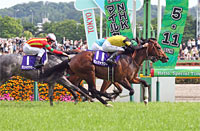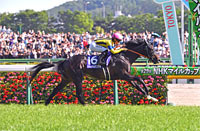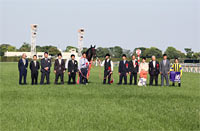NHK Mile Cup (G1) - Data Analysis
3-year-old mile champion decider that is difficult to predict
Runners backed as 1st and 2nd favorites have both produced three winners in the NHK Mile Cup races of the last 10 years, but dark horses have secured the victory in some years. For example, the race was won by 10th favorite Meiner Ho O in 2013 and by 9th favorite Lauda Sion in 2020. So, which way will it go this year? Let's now analyze some features shared by successful runners in this race based on results over the last 10 years.
Runners coming from longer distance races fare well
Looking at performances by runners over the last 10 years in terms of the distance of their previous race, we find that although the runners coming from a 1,600m turf race accounted for just over 50% of the total runners (98 out of 180), they made up only less than 50% of the Top 3 finishers (14 out of 30). Conversely, the group of runners coming from a 2,000m turf race was smaller (19), but produced three winners and achieved higher success ratios. Meanwhile, the runners coming from an 1,800m turf race produced zero winners but four runners-up, a decent performance. In other words, we should raise our expectations of runners that have contested a race with a longer distance than the NHK Mile Cup in their previous race. [Table 1]
[Table 1] Performance by distance of previous race (last 10 years)
| Distance of previous race |
Performance
[1st-2nd-3rd-4th or lower] |
Win ratio |
Top 2 ratio |
Top 3 ratio |
| 1,400m or shorter turf race |
1-2-1-34 |
2.6% |
7.9% |
10.5% |
| 1,600m turf race |
6-3-5-84 |
6.1% |
9.2% |
14.3% |
| 1,800m turf race |
0-4-1-19 |
0% |
16.7% |
20.8% |
| 2,000m turf race |
3-1-3-12 |
15.8% |
21.1% |
36.8% |
| Dirt race |
0-0-0-1 |
0% |
0% |
0% |
Focus on runners that have won an open-class 1,600m turf race
Looking at performances by runners over the last 10 years in terms of experience of winning an open-class 1,600m turf race, we observe that while there is not much difference in the number of Top 3 finishes between runners with and without such experience, the former group achieved higher success ratios. Considering this race determines the mile champion of the generation, we should evidently focus on runners' performance in 1,600m turf races. [Table 2]
[Table 2] Performance by experience of winning an open-class 1,600m turf race (last 10 years)
| Experience |
Performance
[1st-2nd-3rd-4th or lower] |
Win ratio |
Top 2 ratio |
Top 3 ratio |
| Yes |
6-4-4-37 |
11.8% |
19.6% |
27.5% |
| No |
4-6-6-113 |
3.1% |
7.8% |
12.4% |
If we further analyze the performances of runners with experience of winning an open-class 1,600m turf race in terms of their favoritism, we note that runners backed as 3rd favorite or higher achieved an extremely high Top 3 ratio of 58.8%. Meanwhile, runners backed as 4th-9th favorite produced zero Top 3 finishers, while runners backed as 10th favorite or lower delivered four Top 3 finishers. This unusual distribution is worthy of note. [Table 3]
[Table 3] Among runners with experience of winning an open-class 1,600m turf race, performance by favoritism (last 10 years)
| Favoritism |
Performance
[1st-2nd-3rd-4th or lower] |
Win ratio |
Top 2 ratio |
Top 3 ratio |
| 3rd favorite or higher |
5-3-2-7 |
29.4% |
47.1% |
58.8% |
| 4th-9th favorite |
0-0-0-18 |
0% |
0% |
0% |
| 10th favorite or lower |
1-1-2-12 |
6.3% |
12.5% |
25.0% |
Consistent performance also a key factor
Of the 30 Top 3 finishers over the last 10 years, 20 had been beaten to 4th or lower in a JRA race no more than once, and runners in this group occupied the entire Top 3 in the last two years. Meanwhile, runners that had been beaten to 4th or lower in a JRA race two or more times had low success ratios, and produced zero winners since 2016 with performance of [0-1-3-53] (Top 3 ratio of 7.0%). This suggests that consistent performance in past races is also an important factor to take into consideration. [Table 4]
[Table 4] Performance by number of finishes in 4th place or lower in a JRA race (last 10 years)
Number of finishes in 4th
place or lower |
Performance
[1st-2nd-3rd-4th or lower] |
Win ratio |
Top 2 ratio |
Top 3 ratio |
| Once or less |
8-8-4-54 |
10.8% |
21.6% |
27.0% |
| Two times or more |
2-2-6-96 |
1.9% |
3.8% |
9.4% |
Progeny of sires that have won a G1 1,600m turf race at Tokyo perform well
Looking at performances by runners in terms of their sire, we note that progeny of sires that had triumphed in a G1 1,600m turf race at Tokyo Racecourse have produced six winners. For example, the progeny of Yasuda Kinen winner Daiwa Major delivered three wins, a second and two thirds out of 16 runners (Top 3 ratio of 37.5%). In addition, the race was won by Schnell Meister (sired by Kingman) and the third place went to Grenadier Guards (sired by Frankel) last year. As we can see from the result, runners sired by stallions standing overseas achieved a similar Top 3 ratio. If any of this year's runners match this profile, we should keep an eye on them. [Table 5]
[Table 5] Performance by sire (last 10 years)
| Sire |
Performance
[1st-2nd-3rd-4th or lower] |
Win ratio |
Top 2 ratio |
Top 3 ratio |
| Winner of G1 1,600m turf race at Tokyo |
6-3-4-34 |
12.8% |
19.1% |
27.7% |
| Stallions in overseas |
1-2-1-11 |
6.7% |
20.0% |
26.7% |
| Other than the above |
3-5-5-105 |
2.5% |
6.8% |
11.0% |
Note: Shuttle stallions are not included in "Stallions in overseas".
Seek out the winner!
Check the grade of the previous race and the finish in that race
Looking at the previous race of the last 10 winners, we find that four winners had finished in the Top 5 of the Oka Sho (Japanese 1000 Guineas) or Satsuki Sho (Japanese 2000 Guineas). Runners in this group delivered four wins and a second, and achieved a Win ratio of 50.0%. In other words, it appears we can put our trust in runners that have finished in the Top 5 of the Classic races that attracts the top talent of a generation. Five of the remaining six winners had contested a G2 or G3 race while backed as 2nd favorite or higher in their previous race, and finished in the Top 2 of that race. When comparing runners whose previous race was not a Classic race, we should focus on runners that have finished in the Top 2 of their previous race while highly favored. [Table 6]
[Table 6] Winners' previous race (last 10 years)
| Year |
Winner |
Previous race |
Favoritism in previous race |
Finish in previous
race |
| 2012 |
Curren Black Hill |
New Zealand Trophy (G2) |
1st favorite |
1st |
| 2013 |
Meiner Ho O |
New Zealand Trophy (G2) |
4th favorite |
7th |
| 2014 |
Mikki Isle |
Arlington Cup (G3) |
1st favorite |
1st |
| 2015 |
Clarity Sky |
Satsuki Sho (Japanese 2000 Guineas) (G1) |
10th favorite |
5th |
| 2016 |
Major Emblem |
Oka Sho (Japanese 1000 Guineas) (G1) |
1st favorite |
4th |
| 2017 |
Aerolithe |
Oka Sho (Japanese 1000 Guineas) (G1) |
6th favorite |
5th |
| 2018 |
Keiai Nautique |
New Zealand Trophy (G2) |
1st favorite |
2nd |
| 2019 |
Admire Mars |
Satsuki Sho (Japanese 2000 Guineas) (G1) |
2nd favorite |
4th |
| 2020 |
Lauda Sion |
Chunichi Sports Sho Falcon Stakes (G3) |
1st favorite |
2nd |
| 2021 |
Schnell Meister |
Hochi Hai Yayoi Sho (Deep Impact Kinen) (Japanese 2000 Guineas Trial) (G2) |
2nd favorite |
2nd |
(Maya Takanami)
|

- Preview
- Barrier draw
- Past performances of runners

- News
- Race result
- Video
- 2025 English

- 2024 English

- 2023 English

- 2022 English

- 2021 English

- 2020 English

- 2019 English

- 2018 English

- 2017 English

- 2016 English

- 2015 English

- 2014 English

- 2013 English

- Photo Gallery
2025 Winner: Panja Tower


2024 Winner: Jantar Mantar


|



















